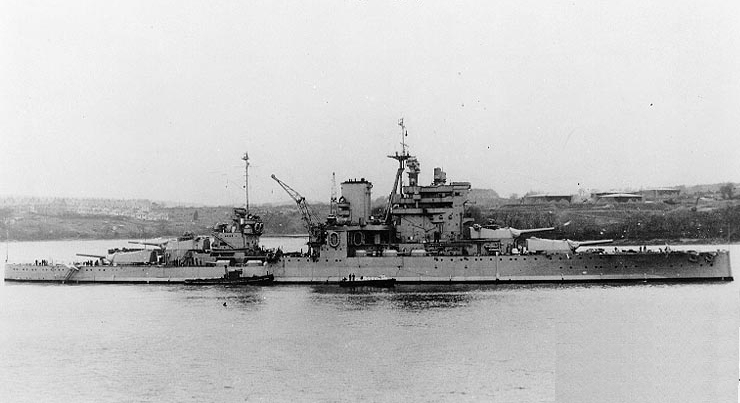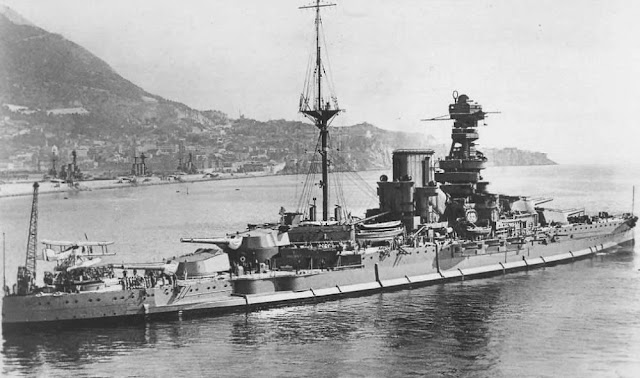HMS Valiant was a Queen Elizabeth-class battleship built for the Royal Navy during the early 1910s. She participated in the Battle of Jutland during the First World War as part of the Grand Fleet. Other than that battle, and the inconclusive Action of 19 August, her service during the war generally consisted of routine patrols and training in the North Sea. She saw further action during the Second World War in the Mediterranean and the Far East.
The Queen Elizabeth-class ships were designed to form a fast squadron for the fleet that was intended to operate against the leading ships of the opposing battleline. This required maximum offensive power and speed several knots faster than any other battleship to allow them to defeat any type of ship.
Valiant had a length overall of 643 feet 9 inches (196.2 m), a beam of 90 feet 7 inches (27.6 m) and a deep draught of 33 feet (10.1 m). She had a normal displacement of 32,590 long tons (33,110 t) and displaced 33,260 long tons (33,794 t) at deep load. She was powered by two sets of Brown-Curtis steam turbines, each driving two shafts, using steam from 24 Yarrow boilers. The turbines were rated at 75,000 shp (56,000 kW) and intended to reach a maximum speed of 24 knots (44.4 km/h; 27.6 mph). Valiant had a range of 5,000 nautical miles (9,260 km; 5,754 mi) at a cruising speed of 12 knots (22.2 km/h; 13.8 mph). Her crew numbered 919 officers and ratings in 1916 and 1,218 in 1919.
The Queen Elizabeth class was equipped with eight breech-loading (BL) 15-inch (381 mm) Mk I guns in four twin gun turrets, in two superfiring pairs fore and aft of the superstructure, designated 'A', 'B', 'X', and 'Y' from front to rear. Twelve of the fourteen BL 6-inch (152 mm) Mk XII guns were mounted in casemates along the broadside of the vessel amidships; the remaining pair were mounted on the forecastle deck near the aft funnel and were protected by gun shields. Their anti-aircraft (AA) armament consisted of two quick-firing (QF) 3-inch (76 mm) 20 cwt Mk I[Note 1] guns. The ships were fitted with four submerged 21 inch (533 mm) torpedo tubes, two on each broadside.
Valiant was completed with two fire-control directors fitted with 15-foot (4.6 m) rangefinders. One was mounted above the conning tower, protected by an armoured hood, and the other was in the spotting top above the tripod foremast. Each turret was also fitted with a 15-foot rangefinder. The main armament could be controlled by 'B' turret as well. The secondary armament was primarily controlled by directors mounted on each side of the compass platform on the foremast once they were fitted in April 1917.
The waterline belt of the Queen Elizabeth class consisted of Krupp cemented armour (KC) that was 13 inches (330 mm) thick over the ships' vitals. The gun turrets were protected by 11 to 13 inches (279 to 330 mm) of KC armour and were supported by barbettes 7–10 inches (178–254 mm) thick. The ships had multiple armoured decks that ranged from 1 to 3 inches (25 to 76 mm) in thickness. The main conning tower was protected by 13 inches of armour. After the Battle of Jutland, 1 inch of high-tensile steel was added to the main deck over the magazines and additional anti-flash equipment was added in the magazines.
The contract for the construction of the Valiant was given to The Fairfield Shipbuilding and Engineering Company, Limited. She was laid down in the same berth where the battlecruiser HMS Indomitable had been built. She was laid down at the Fairfield Shipbuilding and Engineering Company, Govan on 31 January 1913 and launched on 4 November 1914. She was completed in February 1916. On the construction of Valiant by Admiralty contract, Fairfields lost £78,836. Her turbines were manufactured by Fairfields, and her armour plate was provided by William Beardmore and Company. Upon completion on 19 February 1916 under Captain Maurice Woollcombe, she joined the recently formed Fifth Battle Squadron of the Grand Fleet. At the Battle of Jutland, she fired 288 15-inch shells at the German High Seas Fleet. Despite the severity of damage suffered by her sister ships (bar HMS Queen Elizabeth which did not take part in the battle), she suffered no damage. One of her 15-inch guns, which had been in Valiant at Jutland, was later removed and became one of the three guns of the Johore Battery at Singapore. On 24 August 1916, she collided with HMS Warspite and was under repair until 18 September.
From 1919 to the end of 1924 she was part of the 1st Battle Squadron, Atlantic Fleet after which she was with the 1st Battle Squadron of the Mediterranean Fleet until March 1929.
The ship was sent to Liverpool in response to a police strike when rioting broke out in the city.
Between 1929 and 1930 she underwent a major refit. anti-torpedo bulges were added, increasing the beam to 31.70 m. The two funnels were trunked into one and a single octuple 2-pounder mounting was added. Two of the torpedo tubes were removed, and the aircraft platforms were replaced by a single catapult. These modifications brought the maximum displacement up to 35,970 tons.
On 2 December 1930, she was recommissioned for service in the Atlantic wherein 1931 her crew participated in the Invergordon Mutiny. March 1932 saw her transferred to the Home Fleet until in July 1935 she was once again in the Mediterranean.
 |
| Valiant in 1939, showing original casemates plated over and new 4.5-inch guns mounted a deck higher |
Between March 1937 and November 1939, she underwent a complete rebuild at Devonport. The machinery was changed to eight Admiralty 3 drum boilers with four Parsons steam turbines producing a total of 80,000 shp (60,000 kW). Fuel load was 3,393 tons oil, and maximum speed was reduced to 23.5 knots (43.5 km/h; 27.0 mph) despite the increase in power, due to the increase in displacement and draught. Deck armour was increased to 5 inches (130 mm) over the magazines, 2.5 inches over the machinery while the new 4.5" guns had between 1 and 2 inches (51 mm) of armour. The secondary armament was changed to 20 × 4.5 inch Mk I dual-purpose guns in 10 twin mountings and the close-range anti-aircraft armament consisted of four octuple 2 pdr "pom-pom" mountings. The ship's fire control was modernized to include the HACS MkIV AA fire control system and the Admiralty Fire Control Table Mk VII for surface fire control of the main armament. These modifications increased draught to 10 m and maximum displacement to 36,513 tons.
In June 1940, Valiant was assigned to Force H at Gibraltar, under the command of Admiral James Somerville. She took part in Operation Catapult. the attack on French ships at Mers-el-Kébir.
Later she was transferred to the Mediterranean Fleet at Alexandria, under Admiral Cunningham.
Valiant saw action at the Battle of Cape Matapan on 27–29 March 1941, and in the bombardment of Tripoli harbour on 21 April 1941 (accompanied by her sisters Barham and Warspite, the cruiser Gloucester and various destroyers). In May 1941, she operated off Crete and was struck by two bombs.
On 19 December 1941, Valiant was seriously damaged by limpet mines placed by Italian frogmen of Decima Flottiglia MAS, who entered Alexandria harbour riding two-man "human torpedoes" ("maiali"). Her sister ship Queen Elizabeth was also damaged. Lieutenant Durand de la Penne placed the mines on Valiant. The other two teams attached their mines and escaped, but de la Penne's maiale broke down. De la Penne pushed the maiale under Valiant and left it on the bottom. Then he and his companion Corporal Emilio Bianchi emerged and were captured. They were interrogated by Captain Charles Morgan, but told him nothing, despite being locked in a compartment below the waterline. A few minutes before detonation, when it was too late to find and deactivate the mines, he informed Captain Morgan to allow the British to evacuate. They were returned to the locked compartment, which was just above where the mine would explode. De la Penne and Bianchi were injured by the explosion but survived. After the war, no action was taken against Captain Morgan for this patent violation of the Geneva Convention.
The mine attached to Valiant was not actually in contact with her hull, so the damage was far less severe than to Queen Elizabeth. Despite having a heavy trim forward, her decks were above water, and she remained clear of the harbour bottom. Although nearly immobilised she was able, although only for a few days, to give the impression of full battle readiness. This appearance was exploited by the Royal Navy. They allowed photographs of the seemingly undamaged ship to appear in the British press. Valiant was repaired in Durban, South Africa, and returned to the Mediterranean in 1943.
She supported the landings in Sicily (Operation Husky in July) and at Salerno (Operation Avalanche in September).
 |
| Valiant (left) and Richelieu (right) from HMS Queen Elizabeth in the Bay of Bengal during the action against the Japanese at Sabang. |
In 1944, she was sent to the Far East to join the Eastern Fleet. There she took part in raids against Japanese bases in Indonesia. On 8 August 1944, she was severely damaged in an accident with the floating drydock at Trincomalee, Ceylon. The drydock was being raised with Valiant in it by pumping water from ballast tanks. The tanks were emptied in the wrong sequence for Valiant's weight distribution, which was exacerbated by her full munitions load. As a result, the drydock was over-stressed at its ends, broke its back and sank. Valiant's two inner screws were jammed as well as one of her rudders. Valiant had remained in steam and was able to avoid worse damage or sinking. After the incident, the responsible Naval Constructor was disciplined.
It was decided to sail her to Alexandria, where there were suitable docking facilities, However, she could not steer a straight course, and could not make more than 8 knots (15 km/h). She got as far as Suez Bay, but could not attempt the Suez Canal in that condition. Lt Cmdr Peter Keeble, an experienced diver and salvage expert, personally supervised the removal of her two inner screw shafts near the gland. The A-brackets holding the shafts and screws were also cut, dropping both screws and shafts to the bottom. Keeble had perfected available underwater cutting torches by combining British and Italian technology to cut away the thick propeller shafts. She returned to the UK and was decommissioned in July 1945.
Valiant formed part of the Imperieuse stoker mechanics' training establishment at Devonport for the rest of her career. She was sold for scrapping on 19 March 1948 and left Devonport for the breakers of Arnott Young at Cairnryan on 11 August of that year.



No comments:
Post a Comment